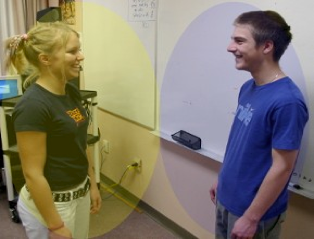Proxemics
 One aspect of proxemics has to do with how close we stand to others. The distance may vary based on cultural norms and the type of relationship existing between the parties.
One aspect of proxemics has to do with how close we stand to others. The distance may vary based on cultural norms and the type of relationship existing between the parties.
Edward T Hall (1966) specified four distance zones which are commonly observed by North Americans.
Intimate distance -
(0" to 18") This zone extends from actual touching to eighteen inches. It is normally reserved for those with whom one is intimate. At this distance the physical presence of another is overwhelming. Teachers who violate students intimate space are likely to be perceived as intruders.
Personal distance (
18" to 4') This zone extends from eighteen inches to four feet. This is the distance of interaction of good friends. This would also seem to be most appropriate distance for teacher and student to discuss personal affairs such as grades, conduct, private problems, etc.
Social distance (
4' to 12') This zone exists from four to twelve feet. It seems to be an appropriate distance for casual friends and acquaintances to interact.
Public distance (12' to 25') Extending outward from twelve feet a speaker becomes formal. Classes of teachers who maintain this distance between themselves and their students are generally formal, and some students may feel that the teacher is cold and distant.
This system provides useful insight into the constructive use of space for various student-teacher interactions. It should be noted, however, that appropriate distance is determined by a myriad of variables including the situation, the nature of the relationship, the topic of conversation, and the physical constraints which are present.
Vertical Distance
Just as the horizontal distance between people communicates something, so does the vertical distance. In this case, however, vertical distance is often understood to convey the degree of dominance or sub-ordinance in a relationship. Looking up at or down on another person can be taken literally in many cases, with the higher person asserting greater status.
Teachers, and especially those who work with small children, should realize that students will interact more comfortably with a teacher when they are in same vertical plane. Used in this way, an understanding of vertical distance can become a tool for improved teacher-student communication. On the other hand, a disciplinarian might put this information to use in order to gain psychological advantage over an unruly student.
Licensed under the Creative Commons Attribution-NonCommercial-ShareAlike 2.5 License
Brought to you by CReducation.org.